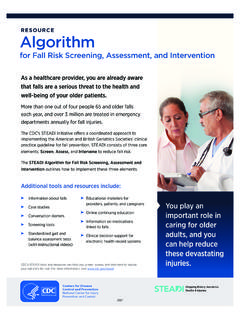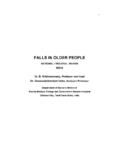Transcription of An overview of best practice for falls prevention from an ...
1 An overview of best practice for falls prevention from an occupational therapy perspective Claire Ballinger and Charlotte Brooks May 2013 2013 The Health Foundation Introduction attention within the falls literature over the last 10 years has been physical exercises to promote The purpose of occupational therapy is to provide strength and balance. occupational therapists practical support to people to do the things have an important role in promoting physical they need or want to do. It enables people of exercise to assist people in carrying out valued all ages to carry out practical and purposeful activities and occupations, and thus fulfilling activities' (or occupations').1 This brief paper meaningful life roles. The two falls prevention provides an overview of the ways in which exercise programmes for which there is most occupational therapists can help older people at evidence are the Otago programme and the falls risk of falls , with a focus on those living in the management exercise (FaME) programme.
2 The community. former is an individually tailored plan designed to be carried out at home,9 while the latter Background provides tailored group The not for Around 30% of people aged 65 years and over profit organisation Later Life Training (http://. living in the community fall each year, and this ) provides evidence figure rises with ,3 Whilst less than 10% based training for instructors to run both of of falls result in fractures, around one in five these programmes and more. falls require medical ,5 In addition, One of the potential challenges which can render there are a range of other consequences which an exercise programme ineffective is difficulty can significantly impact on the life of an older in adhering to it. In an attempt to improve person, including fear of falling, limitations in adherence, occupational therapist Lindy Clemson the activities of daily living, and admission to and colleagues developed the lifestyle integrated supported Consequently, the functional exercise (LiFE) approach, in which prevention of falls in older people has become strength and balance training is integrated into a high priority for health services both in the everyday routines and activities.
3 This has been United Kingdom and internationally. Although proved to be equally as effective in preventing individual risk factors for falls can vary, falls as more traditional exercise particularly with some specific subgroups (see Additionally, websites have been developed to final section), there is a general consensus that provide older people with personalised advice on a combination of regular strength and balance exercise for falls prevention (available at: http://. exercises and environmental modification reduces the rate of falls and the risk of do and ). The person-environment-occupation' model Another area in which occupational therapists provides a useful framework for understanding provide positive help to older people is in both the content and process of delivering improving falls self efficacy, which is essentially the occupational therapy falls prevention degree of confidence that a person has in carrying This model proposes that these out everyday activities without falling.
4 Typically three components continually interact and change, assessed using the falls efficacy scale international and that this impacts on a person's performance or (FES-I),12 a low falls self efficacy, resulting in a function; the better the congruence or fit' between fear of falls , can be a debilitating consequence the components, the better their performance of a fall . occupational therapists play a key role or function. When helping to review and reduce in exploring older people's views about falls and someone's falls risk, occupational therapists take their prevention , discussing potential strategies to a broad holistic view and work together with the improve confidence and planning with the person individual client to consider factors within each of how and when to implement them. these domains and how they Subsequent sections provide more detail. Knowledge of falls prevention strategies remains low among older Through their holistic and collaborative work with clients, occupational occupational therapy interventions therapists are in an excellent position to deliver addressing personal risk factors brief educational interventions in order to help Perhaps the single intervention receiving most prevent falls .
5 occupational therapy research An overview of best practice for falls prevention from an occupational therapy perspective 2. is currently exploring the accessibility and occupational therapy readability of falls prevention information (for example, on websites14), with a view to improving interventions addressing activity its user friendliness and availability to a wide ( occupation') related risk factors range of older people. Health literacy, defined as occupational therapists work with people to representing the cognitive and social skills which review how daily activities can be carried out determine the motivation and ability of individuals safely, and also find ways to enhance opportunities to gain access to, understand, and use information for participation. The assessment of motor in ways which promote and maintain good and process skills (AMPS) is an example of a health,'15 may be important when considering falls .
6 Standardised occupational therapy assessment tool which evaluates the quality of a person's performance in activities of daily living selected occupational therapy by them,20 such as meal preparation and making interventions addressing a bed. Interventions designed to enhance environmental risk factors performance and improve safety might include occupational therapy environmental the provision of adaptive equipment (for example, interventions include home safety, access to a bath board, seat, and rail for use when bathing), aids for communication (for example, pendant major housing adaptations, or advice about alarms), enhancing vision within properties, and alternative ways of carrying out activities of daily footwear occupational therapists living to reduce risk (such as use of a night light have a variety of tools with which to explore when accessing one's bathroom at night).
7 The environmental risk factors for falls . These have cost of a hip fracture is disproportionately large in primarily focused on the home environment and comparison to the cost of minor and even major include the home falls and accidents screening housing tool (HOME FAST) (available at: http://www. occupational therapy research has highlighted ) how falls prevention services designed for older and the Westmead home safety assessment people might inadvertently compromise their (WeHSA),16,17 a standardised measure with good dignity and valued ,23 For occupational inter-rater reliability. Whilst some home hazard therapists therefore, the ways in which they checklists do not require the active participation work with older people to promote safety and of the person, the WeHSA was designed to be participation are as important as the content used together with the client to explore how of the interventions.
8 Recommendations based use of the environment contributes to falls risk. on empirical evidence, including the examples This is one of the key differences in the ways in cited above, suggest ways in which to promote which occupational therapists promote safety; engagement of older people in falls prevention a recent Cochrane review suggested that home safety interventions delivered by an occupational therapist were more successful than those which were Several randomised controlled trials occupational therapy interventions have established the efficacy of home safety focusing on multiple risk modifications in reducing ,19 factors in falls prevention Recent research which includes an occupational In practice , occupational therapists often use therapy perspective has explored the relationship multiple interventions when working with older between older people, outdoor falls , and the people to prevent falls .
9 Gillespie et al (2012) have design of public spaces (available at: http:// highlighted the contribution of these multifactorial interventions in reducing the rate of The surface/research/going-outdoors- falls ,-a geing- Stepping On' programme,27 which is underpinned and-resilience-go-far). Publications are currently by Bandura's (1976) social learning theory,28. in preparation highlighting older people's was designed by an occupational therapist and perspectives about risk factors for outdoor falls combines exercise with a home safety intervention and their prevention , as well as identification of and education, the focus being on falls self efficacy outdoor hotspots' for falls . and adult learning principles. In a randomised controlled trial this programme was shown to be effective in reducing falls by 31%.29. An overview of best practice for falls prevention from an occupational therapy perspective 3.
10 Summary and future areas of work This resource has summarised the evidence based interventions which occupational therapists use to prevent or reduce falls in older people, and has also provided information about how to access resources. In addition, the holistic approach to falls prevention used by occupational therapists, which acknowledges the client at the centre of the intervention, has been highlighted as a critical element of effective and ethical working. Evidence based interventions for falls prevention within occupational therapy have developed exponentially in recent years, and research currently in progress highlights additional areas in which occupational therapists can make a contribution. Waterman et al (2010) are currently conducting a pilot study comparing adherence to two interventions delivered by occupational therapists to prevent falls in older people with visual occupational therapists are also exploring the potential for the translation of general falls prevention literature specifically for people with learning As evidence accrues around the specific challenges experienced by people with different impairments, both in terms of falls risk and access to falls prevention strategies, the potential for effective interventions supported by occupational therapists also grows.






